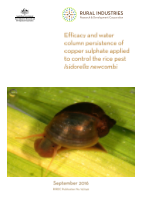Rice Breeding Australia Annual Results: September 2023 to August 2024
As part of this project, Rice Breeding Australia Ltd. (RBA) has rapidly evolved the previous rice breeding program despite significant challenges in its first year...
 RICE
RICE 
36 pages
Published: 9 Sep 2016
Author(s): Stevens, Mark, Doran, Greg
Download report PDF
DownloadPurchase a hard copy - AUD $45.00
Effectively and sustainably managing pests, diseases and weeds is a core industry priority and essential for maximising productivity and hence profitability. The native water snail Isidorella newcombi is one of the key pests that can reduce crop yields. Although this pest can be controlled using crop rotations, this practice conflicts with the imperative of minimising water consumption. Consequently, growers continue to have a strong dependence on chemical control for managing snail infestations.
Copper sulphate has been used for snail control in rice for many years, and has been the only material legally available for this purpose. Its use was authorised under permits of one- to three-years’ duration, issued by the Australian Pesticides and Veterinary Medicines Authority (APVMA) or its predecessor, the National Registration Authority for Agricultural and Veterinary Chemicals. In 2005, the APVMA indicated it would no longer issue permits for copper sulphate. Furthermore, formal registration of this chemical was required to support its continued use. New data on the efficacy and environmental fate of copper applied to NSW rice fields was needed to satisfy the regulatory requirements of the APVMA, and was the stimulus for this project.